|
|

|
|
Author
|
Topic: [Discuss] Gateway lunar orbit outpost
|
Robert Pearlman
Editor Posts: 54830
From: Houston, TX
Registered: Nov 1999
|
 posted 09-17-2017 11:57 AM
posted 09-17-2017 11:57 AM
   
Please use this topic to discuss the Artemis Gateway, the human-tended platform for relay and research in lunar orbit. |
SkyMan1958
Member Posts: 1412
From: CA.
Registered: Jan 2011
|
 posted 10-05-2017 12:35 PM
posted 10-05-2017 12:35 PM
   
Just wondering, was there any sort of a timeline as to when this would theoretically be deployed? If, and I realize it's a big if, NASA (realistically Congress) plans on putting footprints on Mars in the 2030s, then this sort of station in my opinion would need to be up and running no later than 2025. |
Robert Pearlman
Editor Posts: 54830
From: Houston, TX
Registered: Nov 1999
|
 posted 10-05-2017 12:39 PM
posted 10-05-2017 12:39 PM
   
This chart from March shows a provisional deploy of the Deep Space Gateway by 2025 (2026 with an airlock):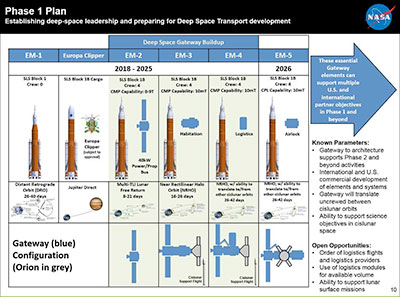 |
Robert Pearlman
Editor Posts: 54830
From: Houston, TX
Registered: Nov 1999
|
 posted 12-06-2018 09:35 AM
posted 12-06-2018 09:35 AM
   
Bill Gerstenmaier shared this updated notional buildup for the Gateway at a NASA Advisory Council meeting today (Dec. 6):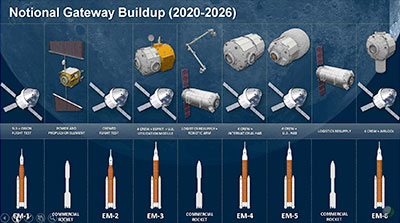 |
Robert Pearlman
Editor Posts: 54830
From: Houston, TX
Registered: Nov 1999
|
 posted 03-11-2019 12:37 PM
posted 03-11-2019 12:37 PM
   
International Space Station Multilateral Coordination Board (MCB) release Looking beyond the ISS, the MCB recalled the historic achievement almost fifty years ago of the first human landing on the Moon. It reviewed the extensive work carried out by the ISS partners to study concepts for extending human exploration to the Moon and subsequently to Mars. Emphasising the importance of affordable and sustainable exploration, the MCB discussed their common interest in deploying a human outpost in the lunar vicinity as the next step. Known as the Gateway, it will serve as a way station one thousand times more distant from Earth than today's ISS, to support exploration of the lunar surface.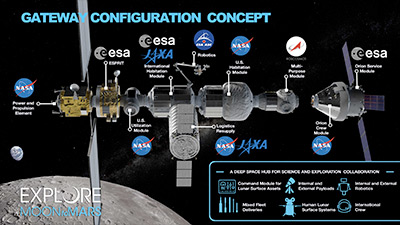 Within a broader open architecture for human lunar exploration, the MCB acknowledged the Gateway as a critical next step. The Gateway will support human and robotic access to the lunar surface, and build invaluable experience needed for the challenges of later human missions to Mars. The unique location of the Gateway will offer a platform for important scientific discovery in a deep space environment very different from that of the ISS and enable lunar surface exploration. Its special orbit will also provide excellent visibility of both the Earth and the Moon's surface for communications relay purposes. It will stimulate the development of advanced technologies, expand the emerging space economy, and continue to leverage the societal benefits of space exploration for citizens on Earth. Gateway will ultimately enable international and commercial partners to participate in human exploration, research and technology development and will be foundational for establishing a sustained human presence around and on the Moon. Following several years of extensive study among the agencies culminating in a successful technical assessment, the MCB endorsed plans to continue the Gateway development. It welcomed each agency's intention to proceed toward their respective stakeholders' approval and funding processes for providing specific elements, modules, and capabilities to the Gateway and associated benefits based on a common concept (see Graphic) The MCB welcomed with enthusiasm Canada's announcement on February 28th, 2019, that it would participate in the Gateway and contribute advanced robotics, making the Canadian Space Agency the first partner agency to join NASA in the Gateway. Finally, recalling the ambition and far-sighted decisions that led to the success of both Apollo and the ISS, MCB members affirmed their common hope that the Gateway should secure new achievements in the field of space exploration, serve as the next step on a sustainable path to the Moon and beyond, and inspire the next generation as a future success of international cooperation in science and technology. |
denali414
Member Posts: 910
From: Raleigh, NC
Registered: Aug 2017
|
 posted 03-21-2019 07:19 AM
posted 03-21-2019 07:19 AM
   
Really like NASA is trying to incorporate as many other nations as can for this project, makes it truly a "world" station, not just an American station.In this world today, more projects that bring nations together for a common goal are welcome and needed. |
SkyMan1958
Member Posts: 1412
From: CA.
Registered: Jan 2011
|
 posted 03-21-2019 05:56 PM
posted 03-21-2019 05:56 PM
   
I absolutely support international cooperation. it's just that as an American taxpayer, if we end up funding 75% of the Gateway, I'd like us to have 75% of the say in how it's used. |
Robert Pearlman
Editor Posts: 54830
From: Houston, TX
Registered: Nov 1999
|
 posted 03-21-2019 08:46 PM
posted 03-21-2019 08:46 PM
   
As Jim Bridenstine is fond of saying, the Gateway is not a space station. Visitors will come and go. It is possible, though not likely, that international visitors will be there when no Americans are in space (or when American astronauts are on the surface of the moon). In any case, like the ISS, the U.S. will get from the Gateway what it needs. |
Robert Pearlman
Editor Posts: 54830
From: Houston, TX
Registered: Nov 1999
|
 posted 05-06-2020 10:23 AM
posted 05-06-2020 10:23 AM
   
The first two elements of the Gateway will be launched in 2023 as an integrated unit, reports Ars Technica. This means that the Power and Propulsion Element built by Maxar and the pressurized Habitation and Logistics Outpost built by Northrop Grumman will be assembled together on the ground and then launched on a commercial rocket.By law, this launch must be competitively bid. But NASA has already studied the combined Gateway to ensure that at least one rocket flying today—SpaceX's Falcon Heavy booster—could loft it to lunar orbit. "We assured ourselves that it could be done with the Falcon Heavy," Loverro said. "We haven't selected the launch vehicle yet, but we had to assure ourselves that there would be at least one vehicle for it. And so we know the Falcon Heavy can do it, and we know that because they have to meet an Air Force Department of Defense requirement for an extended fairing. So there could be more than one option, but we had to verify at least one." Assembling the two initial elements of the Gateway on the ground reduces risk and saves the space agency money, Loverro said. "Quite frankly, it creates a much better foundation for the future," he said. "So we're really happy about that one." |
Robert Pearlman
Editor Posts: 54830
From: Houston, TX
Registered: Nov 1999
|
 posted 05-13-2020 01:01 PM
posted 05-13-2020 01:01 PM
   
NASA's plan to launch Gateway as an integrated payload, as it exists today, from the NASA Advisory Committee Human Exploration and Operations (HEO) meeting on Wednesday (May 13). 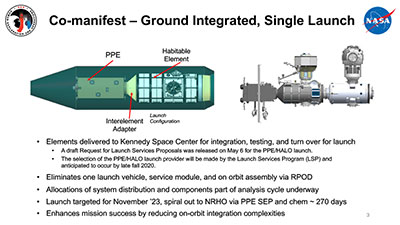 |
SkyMan1958
Member Posts: 1412
From: CA.
Registered: Jan 2011
|
 posted 10-27-2020 11:33 AM
posted 10-27-2020 11:33 AM
   
I see that ESA's concept of Gateway is arranged differently than the last NASA concept I saw of Gateway, although that shouldn't make a huge difference as all the same pieces are there. Since Gateway is technically different than Artemis I can see how ESA has signed on without all the member states signing the Artemis Accords bilaterally with the US. Still, the whole point of Gateway is to get to the Moon. At this point in time I'm not seeing anything in the Artemis plans for an ESA contribution. Is there anything of the sort being contemplated? |
Robert Pearlman
Editor Posts: 54830
From: Houston, TX
Registered: Nov 1999
|
 posted 10-27-2020 11:48 AM
posted 10-27-2020 11:48 AM
   
Gateway is part of NASA's Artemis Plan and program. It is considered, as of now, central to establishing a sustained presence on the moon.The Artemis Accords are bilateral agreements between countries involved in lunar exploration and the United States. ESA, as a multi-national organization, is not party to the Artemis Accords. ESA's involvement in the Artemis program is not contingent on all of its partner nations signing the Accords (per NASA). NASA's needs from the Gateway have been met by the initial U.S.-built components (power and propulsion element and habitation and logistics outpost). Additions, such as the Canadian Space Agency's Canadarm3 and ESA's I-Hab and ESPRIT modules will enhance the Gateway's capabilities, but are not essential to NASA's lunar surface plans. The idea behind the Gateway's international contributions are that partner nations can add components to expand the platform to support their own lunar plans as well as take part in NASA's lunar surface activities. |
Robert Pearlman
Editor Posts: 54830
From: Houston, TX
Registered: Nov 1999
|
 posted 11-10-2020 11:39 AM
posted 11-10-2020 11:39 AM
   
NASA Office of Inspector General (OIG) release NASA's Management of the Gateway Program for Artemis MissionsIn March 2019, the Administration directed NASA to execute a plan to land humans on the Moon's South Pole by 2024, 4 years sooner than NASA's intended schedule. In response, the NASA Administrator announced that the return-to-the-Moon mission would be known as Artemis and the Agency would use innovative acquisition practices to help accelerate the timetable. The Artemis program includes two exploration missions to orbit the Moon in 2021 and 2023 using the Space Launch System rocket and Orion Multi-Purpose Crew Vehicle (Orion), both of which remain under development and have yet to be flown together. To conduct a lunar landing, the Agency must develop a Human Landing System, complete development of a new spacesuit, and conduct robotic exploration of the proposed landing sites. Moving forward, NASA also plans to build the Gateway — essentially, a small space station — to provide a staging location for additional lunar missions and future deep space operations. Gateway's initial elements, scheduled to launch together in early 2024, consist of the Power and Propulsion Element (PPE), which powers and propels the spacecraft in orbit, and the Habitation and Logistics Outpost (HALO), which provides a docking location for the Orion capsule and living and working spaces for crewmembers. To date, NASA has spent over half a billion dollars and almost 3 years of design work on the PPE and HALO. To reduce the time needed to acquire these two Gateway elements, NASA modified its standard acquisition practices and instead used a fixed-price contract designed for commercial research and development and a sole-source award. Specifically, the Agency competitively awarded a contract to Maxar Technologies (Maxar) in May 2019 to develop the PPE and made a sole-source award to Northrop Grumman (Northrop) in July 2019 for the HALO. The Agency awarded these contracts before requirements were firm and before it decided whether to use the Gateway to support the planned 2024 Moon landing. This report is one in a series of audits examining NASA's Artemis program. In this audit, we assessed to what extent the PPE and HALO are meeting schedule, cost, and performance goals. To complete this work, we reviewed the Gateway's schedule, funding documentation, and acquisition method. For PPE and HALO, we reviewed contract files, cost and budget documentation, performance updates, schedule data, and technical risks. We also reviewed HALO's sole-source documentation. In addition, we interviewed NASA, Maxar, and Northrop officials. What We Found The development schedules for both the PPE and HALO have been negatively impacted by the Agency's still-evolving Gateway requirements, including NASA's decision to co-manifest and launch the two elements on the same commercial rocket rather than separately as initially intended. Given this decision, the PPE is likely to launch at least 17 months behind its original date of December 2022 while HALO has 2 to 5 months of schedule risk, potentially moving its launch readiness date further into 2024. Compounding these issues is the 2024 lunar mandate that drove the accelerated development schedule in the first place and resulted in a lack of schedule margin in the Gateway Program. While NASA policies identify the need for sufficient schedule margin in development programs, we found Gateway officials had no guidance on suggested margins from the Human Exploration and Operations Mission Directorate (HEOMD) — organizationally where the Gateway Program is located — to factor into their schedules. With both the PPE and HALO elements highly dependent on each other due to the decision to co-manifest the systems, coupled with an expected 10-month travel time to lunar orbit, the Gateway likely will not be in a position to support a 2024 lunar landing. The decision to launch the PPE and HALO together, while avoiding the cost of a second commercial launch vehicle, has contributed to cost increases due to the redesign of several components, an elevated launch risk, and a longer duration flight to lunar orbit. In addition, due to the decision Maxar was forced to terminate its subcontract with Space Exploration Technologies Corp (SpaceX) for PPE launch services, even though Maxar had already paid SpaceX approximately $27.5 million for this service, a portion of which was paid by NASA prior to the termination. Further, a co-manifested launch increases risk because together the elements may be too heavy for commercially available rockets or too long for the rocket's fairing, potentially impacting intended spacecraft mass, length, and other requirements. If it is able to address these risks, NASA may receive benefits from co-manifesting, such as avoiding a rendezvous in orbit by integrating both components on the ground before launch. NASA selected Maxar in May 2019 to provide the PPE under a fixed-price contract because the Agency anticipated few design and development changes. However, the contract value has increased by $78.5 million since the award, with more increases expected to accommodate additional evolving requirements and technical challenges. PPE has also experienced other contract management challenges, including the collapse of negotiations between Maxar and a subcontractor to provide its high-power electric propulsion system. For HALO, the Agency awarded Northrop a sole-source contract in order to meet the 2024 goal. Despite NASA's standard requirement to definitize a contract's final terms, conditions, and costs within 6 months of issuance, the Agency did not definitize the contract with Northrop for 10 months due to the lack of defined requirements. Moreover, NASA and Northrop had only agreed to contract costs on a cost-reimbursable basis for a 7-month design phase. The Agency plans to spend over $200 million on habitation design by January 2021, and we anticipate a significant increase in cost if NASA is unable to negotiate the 2021 to 2026 performance period as fixed-price. We also expect further schedule delays and cost increases for HALO due to additional undefined requirements, adjustments to projected budgets that removed a second U.S. habitat, and technical challenges. In our judgment, NASA's acceleration of the acquisition for both the PPE and HALO before fully defining the Gateway's requirements added significant costs to the projects' development efforts and increases the risk of future schedule delays and additional cost increases. What We Recommended To increase the efficiency and effectiveness of NASA's Gateway Program, we recommended NASA's Associate Administrator for HEOMD: - baseline the Gateway requirements and specifications in contract modifications prior to updating and awarding the PPE and HALO fixed-price contracts;
- ensure PPE and HALO delivery and launch dates are realistic by including sufficient schedule margin in their development schedules;
- develop a HEOMD policy that establishes a reasonable amount of recommended schedule margin by phase of program or project;
- confirm at selection the launch system provider for the co-manifested PPE and HALO will meet spacecraft mass, length, and other requirements;
- work with the contractors to obtain a credit for the amount already spent on launch services under the PPE contract;
- take action to enforce NASA policy to definitize contracts within 6 months of award;
- definitize the remaining development and delivery portion of the HALO contract by Preliminary Design Review plus 3 months; and
- ensure the maturity of system requirements are fully understood before selecting the acquisition method and contract type for future acquisition strategies supporting Artemis and Mars missions.
We provided a draft of this report to NASA management who concurred with our recommendations and described planned actions to address them. We consider the proposed actions responsive to our recommendations and will close the recommendations upon their completion and verification. |
SkyMan1958
Member Posts: 1412
From: CA.
Registered: Jan 2011
|
 posted 02-21-2021 05:26 PM
posted 02-21-2021 05:26 PM
   
While I understand that SpaceX will be sending supply missions to Gateway, does anyone know if either ESA or JAXA will too? |
Robert Pearlman
Editor Posts: 54830
From: Houston, TX
Registered: Nov 1999
|
 posted 02-21-2021 05:31 PM
posted 02-21-2021 05:31 PM
   
ESA's agreement does not mention resupply services (as announced). JAXA "is investigating enhancements to its HTV-X cargo resupply spacecraft, which could result in its use for Gateway logistics resupply." |
Headshot
Member Posts: 1418
From: Vancouver, WA, USA
Registered: Feb 2012
|
 posted 10-02-2022 08:34 PM
posted 10-02-2022 08:34 PM
   
Does anyone know if the HALO/PPE elements of the lunar Gateway are still on track for a November 2024 launch? |
Robert Pearlman
Editor Posts: 54830
From: Houston, TX
Registered: Nov 1999
|
 posted 08-07-2023 08:10 PM
posted 08-07-2023 08:10 PM
   
A new (as of June 2023) infographic showing the Gateway configuration: This infographic shows each element of Gateway, humanity's first space station in lunar orbit as a vital component of the Artemis to return to the Moon for scientific discovery and chart the path for the first human missions to Mars. 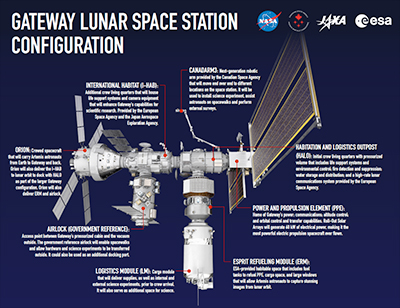 |
Headshot
Member Posts: 1418
From: Vancouver, WA, USA
Registered: Feb 2012
|
 posted 01-07-2024 12:22 PM
posted 01-07-2024 12:22 PM
   
NASA and the Mohammed bin Rashid Space Centre (MBRSC) of the United Arab Emirates (UAE) announced Sunday (Jan. 7) plans for the space centre to provide an airlock for Gateway, humanity's first space station that will orbit the Moon. Didn't NASA originally hope to get Roscosmos to supply this airlock? Or am I thinking of another Gateway module? |
Robert Pearlman
Editor Posts: 54830
From: Houston, TX
Registered: Nov 1999
|
 posted 01-07-2024 04:04 PM
posted 01-07-2024 04:04 PM
   
NASA didn't hope; Roscosmos volunteered (or at least proposed) but then Russia decided it could not sign the Artemis Accords and talks of any partnership ended. |
issman1
Member Posts: 1178
From: UK
Registered: Apr 2005
|
 posted 07-04-2025 04:40 PM
posted 07-04-2025 04:40 PM
  
So is Gateway's future secured as funding for it appears in Trump's One Big Beautiful Bill? |
Robert Pearlman
Editor Posts: 54830
From: Houston, TX
Registered: Nov 1999
|
 posted 07-04-2025 05:17 PM
posted 07-04-2025 05:17 PM
   
At the moment, it is not clear, as Marcia Smith with Space Policy Online points out: The Senate version included sections crafted by the Senate Commerce, Science, and Transportation Committee, which is chaired by Sen. Ted Cruz (R-TX)... The provisions for the Gateway, SLS, Orion and ISS directly contradict President Trump's FY2026 budget request. It calls for termination of the Gateway program...Sen. Cruz is a close Trump ally, putting them at cross-purposes on the Artemis and ISS programs. Whether they've reached an understanding that these programs will proceed as the bill specifies isn't publicly known. The Constitution gives Congress the power of the purse and the Executive Branch is supposed to spend the money as Congress directs, but the Trump Administration is testing those limits. |
Headshot
Member Posts: 1418
From: Vancouver, WA, USA
Registered: Feb 2012
|
 posted 07-04-2025 08:36 PM
posted 07-04-2025 08:36 PM
   
I wonder if Gateway components can be repurposed for some manned Mars exploration craft? | |
Contact Us | The Source for Space History & Artifacts
Copyright 1999-2025 collectSPACE. All rights reserved.

Ultimate Bulletin Board 5.47a
|
|

|
 advertisement advertisement

|
















